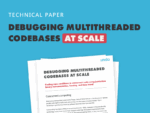Wednesday was the last day at #62DAC for me and I attended an Exhibitor Session entitled, Engineering the Semiconductor Digital Thread, which featured Vishal Moondhra, VP Solutions Engineering of Perforce IPLM and Michael Munsey, VP Semiconductor Industry at Siemens Digital Industries. Instead of just talking from slides,… Read More
Electronic Design Automation
Synopsys Enables AI Advances with UALink
The evolution of hyperscale data center infrastructure to support the processing of trillions of parameters for large language models has created some rather substantial design challenges. These massive processing facilities must scale to hundreds of thousands of accelerators with highly efficient and fast connections.… Read More
Cocotb for Verification. Innovation in Verification
This time let’s see if we can stir up some lively debate. Cocotb isn’t new but it is an interesting alternative to mainstream testing methodologies. Paul Cunningham (GM, Verification at Cadence), Raúl Camposano (Silicon Catalyst, entrepreneur, former Synopsys CTO and lecturer at Stanford, EE292A) and I continue our series … Read More
Breaking out of the ivory tower: 3D IC thermal analysis for all
Todd Burkholder and Andras Vass-Varnai, Siemens EDA
As semiconductor devices become smaller, more powerful and more densely integrated, thermal management has shifted from an afterthought to a central challenge in modern IC design. In contemporary 3D IC architectures—where multiple chiplets are stacked and closely arrayed—power… Read More
A Big Step Forward to Limit AI Power Demand
By now everyone knows that AI has become the all-consuming driver in tech and that NVIDIA GPU-based platforms are the dominant enabler of this revolution. Datacenters worldwide are stuffed with such GPUs, serving AI workloads from automatically drafting emails and summarizing meetings to auto-creating software and controlling… Read More
Free and Open Chip Design Tools: Opportunities, Challenges, and Outlook
Designing semiconductor chips has traditionally been costly and controlled by a few major Electronic Design Automation (EDA) vendors—Cadence, Synopsys, and Siemens EDA who dominate with proprietary tools protected by NDAs and restrictive licenses. Fabrication also requires expensive, often export-controlled equipment.… Read More
Silvaco: Navigating Growth and Transitions in Semiconductor Design
Silvaco Group, Inc., a veteran player in the EDA and the TCAD space, continues to evolve amid the booming semiconductor industry. Founded in 1984 and headquartered in Santa Clara, California, Silvaco specializes in software for semiconductor process and device simulation, analog custom design, and semiconductor intellectual… Read More
Taming Concurrency: A New Era of Debugging Multithreaded Code
As modern computing systems evolve toward greater parallelism, multithreaded and distributed architectures have become the norm. While this shift promises increased performance and scalability, it also introduces a fundamental challenge: debugging concurrent code. The elusive nature of race conditions, deadlocks, … Read More
Perforce Webinar: Can You Trust GenAI for Your Next Chip Design?
GenAI is certainly changing the world. Every day there are new innovations in the use of highly trained models to do things that seemed impossible just a short while ago. As GenAI models take on more tasks that used to be the work of humans, there is always a nagging concern about accuracy and bias. Was the data used to train the model … Read More
A Principled AI Path to Spec-Driven Verification
I have seen a flood of verification announcements around directly reading product specs through LLM methods, and from there directly generating test plans and test suite content to drive verification. Conceptually automating this step makes a lot of sense. Carefully interpreting such specs even today is a largely manual task,… Read More











Jensen Huang Drops Donald Trump Truth Bomb on Joe Rogan Podcast